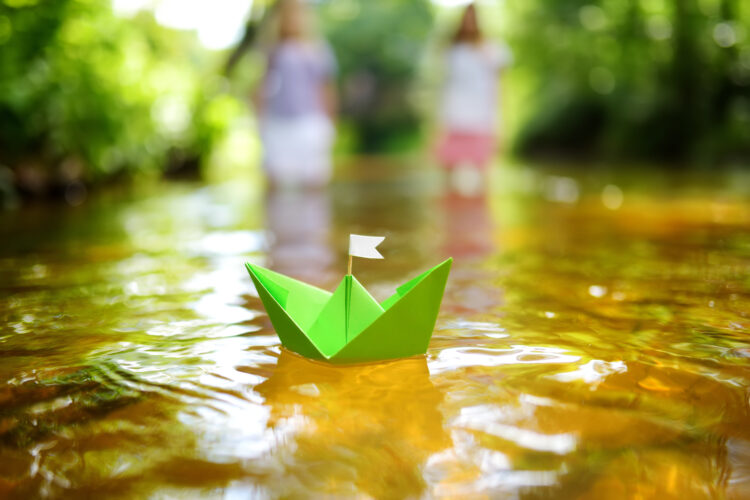Exploring Buoyancy with Paper Boats
Archimedes didn’t invent boats, but his thinking about them is important for understanding why boats float! Archimedes was a classical Greek thinker and tinkerer who lived from about 287 B.C. to 212 B.C.E. He realized (while in the bathtub, according to history) that the weight of the water that is pushed out of the way is equal to the lifting force on that object. In this activity, you will apply Archimedes principles and design thinking to paper boats, as you investigate the factors that affect their buoyancy and stability. Learners will also explore how different design modifications impact the boats floating ability. This promotes critical thinking and problem-solving skills as learners investigate the impact of different design modifications on the boats’ ability to float and remain stable in water.
From: 9 Fun Science Activities. Click here to find links to the other 8 activities!
Materials for Exploring Buoyancy with Paper Boats
- Construction paper or lightweight cardstock
- Scissors
- Ruler or measuring tape
- Clear plastic tub or basin filled with water
- Small weights (e.g., pennies, small rocks)
- Stopwatch or timer
- Optional: Markers or colored pencils for decorating the paper boats
Procedure for Exploring Buoyancy with Paper Boats
- Discuss the concept of buoyancy and how it relates to the ability of objects to float. There are many good YouTube videos on this topic.
- Drop a coin into water and watch it sink. Look at pictures of large ships and ask kids to form a hypothesis about why the coin sinks and they float even though they are made of metal like the coin.
- Begin with a basic paper boat design. https://youtu.be/vNba3jbBSOw has good instructions. The steps are as follows:
- Cut a rectangular piece of construction paper, approximately 20 cm by 30 cm (adjust the size if needed).
- Fold the rectangular paper in half lengthwise to create a crease, then unfold it.
- Fold the shorter edges of the paper towards the center crease, overlapping them slightly. These folds will form the sides of the boat.
- Fold up the bottom edge of the paper to create a triangular shape and fold it back down to secure the sides of the boat.
- Fold down the top edge of the paper to create a straight edge for the boat’s top.
- Test the initial boat design by placing it gently in the water and observing if it floats. If necessary, make adjustments to ensure it floats without sinking or capsizing.
- Record the time it takes for the boat to sink or capsize. Note any observations about its stability or balance.
- Explore the impact of design modifications on the boat’s buoyancy. Consider factors such as size, shape, or weight distribution.
- Make modifications to the boat design, such as altering the size, adding flaps, or changing the shape of the boat’s hull.
- Create multiple boats with different design modifications, ensuring that each boat is the same size and weight.
- Test each modified boat by placing it in the water and recording the time it takes to sink or capsize. Compare the results to the initial boat design.
- Place weights in the boat as you analyze the data and observations to identify the design factors that positively or negatively affect buoyancy and stability.
- Discuss the principles of buoyancy and stability and how they relate to the design modifications. What design factors contributed to improved buoyancy or stability? Which factors caused the boats to sink or capsize?
- Optional: Decorate the paper boats using markers or colored pencils to personalize their appearance.
- Repeat the experiments multiple times to ensure consistent results and verify the findings.
Check out more articles through the Ask Blair Page on this website. This article was submitted in April 2023 and was not published in the July issue of the SEA Homeschoolers Magazine.
Do you have a question for the fan-favorite column “Ask Blair” found in The SEA Homeschoolers Magazine? Please use this form to submit your homeschooling questions. The SEA team will select a few questions to be answered by SEA Homeschoolers Founder & Magazine Editor, Blair Lee, in each quarterly issue. Due to space, not all questions will be published in the magazine. Those that come in shortly after a magazine issue has been published will go on this page. These are important questions and we want to answer them for you in a timely way. Please be sure to include all pertinent information relevant to your question – examples: learner ages, grade levels, preferred resource format, topics of interest, preferred homeschool methodologies, state requirements you’re trying to meet, learning challenges, etc.
Submit your homeschooling question through this link.

